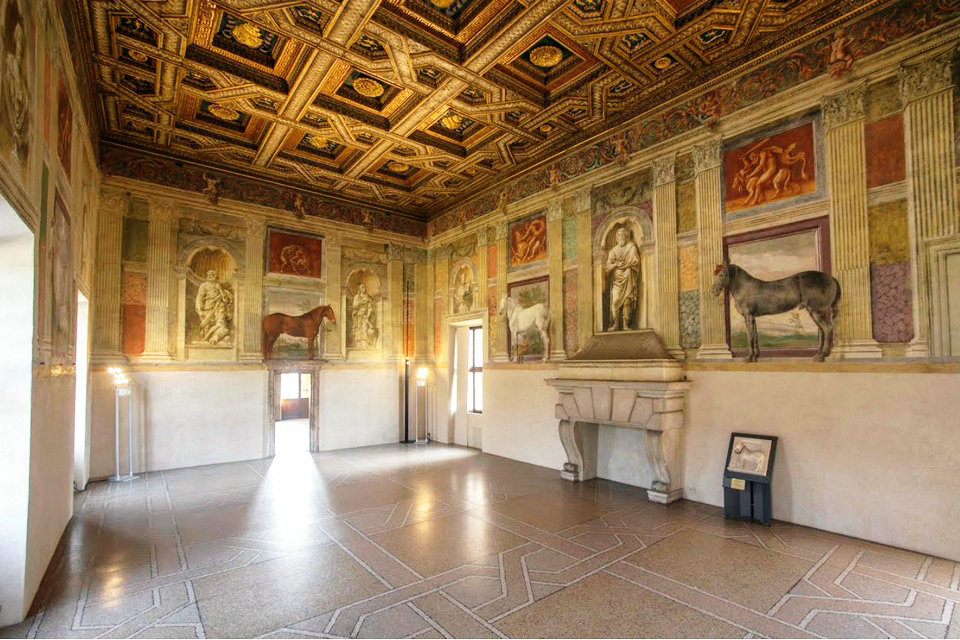Hall of the Horses, 360° Video, Palazzo Te


Hall of horses: with the life-size portraits of the Gonzaga’s six favorite steeds was the ballroom. The horses stand out in all the beauty of their forms on a natural landscape that opens behind some Corinthian columns painted and that alternate the thoroughbred with figures of mythological divinities in false niches. The wooden coffered ceiling and gilded rosettes house Mount Olympus and the lizard, the symbols of the duke and his scheme is taken from the floor giving symmetry to the environment (the floor is not the original of the time).
The Hall of the Horses is adorned with frescoes that display the highest pictorial quality of the entire building. The author of these paintings is not mentioned in any documents; they have been attributed to Giulio Romano, who’s pictorial talent here reached its peak. The room owes its name to the beloved horses of the Gonzaga stables, depicted in the decorations, the way the dogs are painted in the Bridal Chamber by Andrea Mantegna, although here there are no human figures. Each one bears its name, four in particular stand out: Morel Favorito, Glorioso, Bataglia, Dario.
The genius of Giulio Romano is visible not only in the representation of the individual horses, that here are depicted in a position of rest, yet seem to be vibrating. They are standing against openings inside which a painted landscape is visible, and the city of Mantua, with its classical architecture. The entire Chamber, which is embellished by a fireplace made with Istria marble, becomes a fake loggia, that enters into an imaginary dialogue with the Camera Picta, where the Gonzaga family is portrayed inside a large pavilion, beyond which we see some villages. Giulio Romano’s ability to add new elements to the Chamber is evident also if we look at the series of fake painted bronzes in which the labours of Hercules are depicted. The contrast between the calm horse and the twisted body of the hero is magnificent.
In the Hall of Horses there are also real windows which disturb the overall rhythm of the composition, but also show Giulio Romano’s ability in taking advantage of obstacles to create a perfect mix of artifice and reality. The decoration on the walls is completed by large statues of divinities which probably allude to Federico and his lover Isabella Boschetti. Under the magnificent ceiling there is a slot with vegetal motifs and cherubs playing around grotesque masks.
The wood ceiling – one masterpiece inside another – is divided into a series of squares. Inside these the two heroic deeds, the scene of Mount Olympus and the story of the Salamander, are represented. They are enclosed by geometrical and vegetal motifs.
Mount Olympus, which ideally connects the gods to men, that is also an allusion to the solidity of the Gonzaga lineage, is rendered in a plastic way by the golden rocks that stand against a blue sky.
It is not of fundamental importance to determine whether here the painting depicts a lizard, a salamander or a gecko. What is significant is the contrast between the cold skin of the animal and the fire of passions tormenting man. The Latin motto that refers to this scene reads: “Quod huic deest me torquet”, which means “That which she misses torments me”. The heat, unknown to the Salamander, forces the heart of men to suffer the effects of passion.
Palazzo Te
The Palazzo Te is a historic and monumental building in Mantua. a fine example of the mannerist style of architecture, Built between 1524 and 1534 on commission by Federico II Gonzaga, it is the most famous work of the Italian architect Giulio Romano. The complex is now home to the civic museum and, since 1990, the International Center for Art and Culture of Palazzo Te which organizes exhibitions of ancient and modern art and architecture.